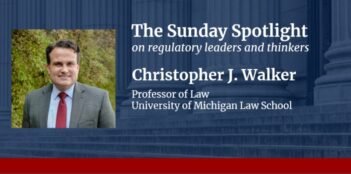
Scholar discusses the role of policy learning and reputation in regulatory excellence.
Regulators must often make difficult decisions based on uncertain or limited information. When it comes to issues of public health or safety, these decisions can become even more difficult due to media scrutiny and public criticism.
In his chapter of the new book, Achieving Regulatory Excellence, David Vogel, a professor at the Haas School of Business at the University of California, Berkeley, examines a few different regulatory responses to issues of public health, safety, and the environment, including pharmaceutical regulation in the United States and Europe. From these examples, Vogel distills principles that are key to successful regulation—in particular, the ability to respond to new information as it emerges and to recognize the accomplishments and shortcomings of previous decisions.
Vogel highlights these principles in one case study comparing the regulation of thalidomide, a pharmaceutical drug marketed toward pregnant women, by the U.S. Food and Drug Administration (FDA) with regulation of this drug by the FDA’s various European counterparts. European regulators approved thalidomide in the 1950s to treat morning sickness in pregnant women, and the drug quickly became popular among pregnant women in Europe. Unbeknownst to regulators, although thalidomide was effective in treating morning sickness, it also produced devastating side effects, including birth defects.
By the time regulators in Europe banned the drug, thousands of children there had been born with birth defects. Of the children who were exposed, half died by their first birthday, Vogel notes.
By contrast, the United States was spared this public health calamity due to the diligence of the FDA, which never approved thalidomide for use. In the aftermath of the thalidomide crisis, the FDA emerged as setting the international “gold standard” among drug regulators.
According to Vogel, this crisis spurred different responses among pharmaceutical regulators. In the United States, the FDA further strengthened its pre-market requirements in response to a congressional mandate to impose standards that were “the most stringent in the world.” By contrast, European regulators chose to strengthen their ability to remove drugs that caused adverse effects.
These early attitudes toward pharmaceutical regulation had significant impacts on subsequent pharmaceutical development and approval in the United States and Europe, Vogel notes. After the immediate response to the thalidomide crisis had faded, the relative rigidity and length of the FDA approval process became a flashpoint for criticism. American politicians and federal bodies like the U.S. Government Accountability Office observed that new drugs were available in Europe months before they became available in the United States.
Critics of the FDA were now, as Vogel describes it, accusing the agency of creating a “drug lag” that deprived Americans of necessary drugs.
This criticism reached a flashpoint during the AIDS crisis of the 1980s, when public opinion forced the FDA to reevaluate its approach toward drug approval. Vogel notes that, until then, the FDA had been unwilling to change its drug approval policies. The FDA had defined its mission as protecting the public from unsafe drugs, but had not recognized that the public could “also be harmed by drug approval standards and requirements that were too stringent.” In addition, the FDA had learned that it had “nothing to gain from approving an effective drug and everything to lose from making a mistake”—a risk-averse approach that encouraged lengthy approval processes.
Although the FDA ultimately approved a drug for the treatment of AIDS in eighteen months—an unprecedented pace—the agency faced ongoing public criticism. The time had come for the FDA to engage in policy learning from its counterparts in Europe.
According to Vogel, the agency took several critical steps to reduce drug approval times, many of which were inspired by practices in Europe. The FDA began to require pharmaceutical companies to pay for drug applications, and the agency used the funds to expedite approval times. It also began allowing third parties to assess drug safety for the first time. These changes, Vogel notes, produced results, and “median approval time for all drugs fell to a little over a year.”
The regulatory history of drug regulation in the United States and Europe highlights some of the principles that Vogel observes as being key to regulatory excellence.
Even regulators with a reputation for excellence, such as the FDA after thalidomide, must remain “willing to learn, by continually monitoring and reassessing both their own policy impact and that of other regulatory authorities who face similar challenges.” This may involve learning from less prominent agencies that do not have a reputation for excellence, Vogel notes.
Furthermore, regulators must stay “responsive to changes in the public’s policy preferences and risk assessments, as well as to policy outcomes.” This flexibility ensures that regulators can respond to changing public needs, such as the demand for new drugs during the AIDS crisis, while fulfilling their mandate to serve the public.
Vogel’s chapter is part of Achieving Regulatory Excellence, a new book published by the Brookings Institution and edited by University of Pennsylvania Law School Professor Cary Coglianese, who serves as the director of the Penn Program on Regulation.
This essay is part of a ten-part series, entitled In Pursuit of Regulatory Excellence.



